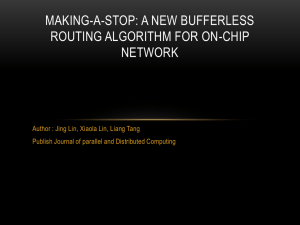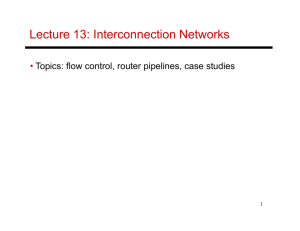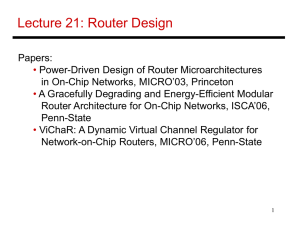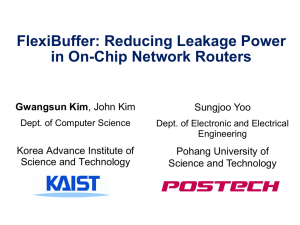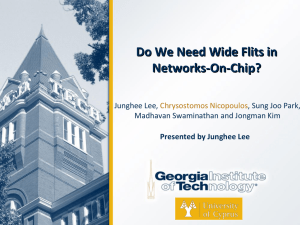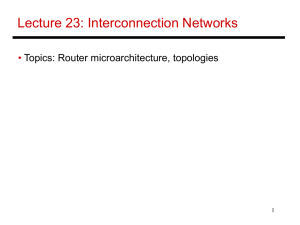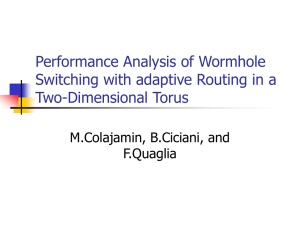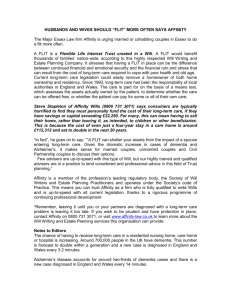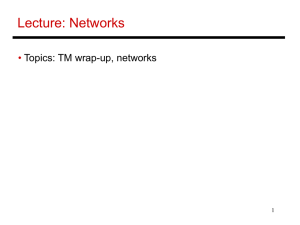Lecture 13: Interconnection Networks • Topics: flow control, router pipelines, case studies 1
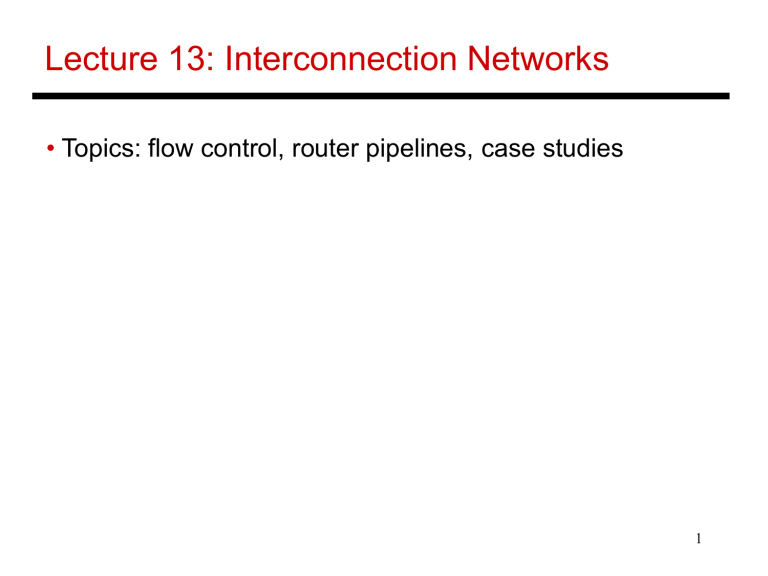
Lecture 13: Interconnection Networks
• Topics: flow control, router pipelines, case studies
1
Packets/Flits
• A message is broken into multiple packets (each packet has header information that allows the receiver to re-construct the original message)
• A packet may itself be broken into flits – flits do not contain additional headers
• Two packets can follow different paths to the destination
Flits are always ordered and follow the same path
• Such an architecture allows the use of a large packet size (low header overhead) and yet allows fine-grained resource allocation on a per-flit basis
2
Flow Control
• The routing of a message requires allocation of various resources: the channel (or link), buffers, control state
• Bufferless: flits are dropped if there is contention for a link, NACKs are sent back, and the original sender has to re-transmit the packet
• Circuit switching: a request is first sent to reserve the channels, the request may be held at an intermediate router until the channel is available (hence, not truly bufferless), ACKs are sent back, and subsequent packets/flits are routed with little effort (good for bulk transfers)
3
Buffered Flow Control
• A buffer between two channels decouples the resource allocation for each channel – buffer storage is not as precious a resource as the channel (perhaps, not so true for on-chip networks)
• Packet-buffer flow control: channels and buffers are allocated per packet
Store-and-forward
H B B B T
Time-Space diagrams
2
3
0
1 H B B B T
H B B B T
Cut-through
0
1
2
3
H B B B T
H B B B T
H B B B T
0 1 2 3 4 5 6 7 8 9 10 11 12 13 14
Cycle
4
Flit-Buffer Flow Control (Wormhole)
• Wormhole Flow Control: just like cut-through, but with buffers allocated per flit (not channel)
• A head flit must acquire three resources at the next switch before being forwarded:
channel control state (virtual channel, one per input port)
one flit buffer
one flit of channel bandwidth
The other flits adopt the same virtual channel as the head and only compete for the buffer and physical channel
Consumes much less buffer space than cut-through routing – does not improve channel utilization as another packet cannot cut in (only one VC per input port)
5
Virtual Channel Flow Control
• Each switch has multiple virtual channels per phys. channel
• Each virtual channel keeps track of the output channel assigned to the head, and pointers to buffered packets
• A head flit must allocate the same three resources in the next switch before being forwarded
• By having multiple virtual channels per physical channel, two different packets are allowed to utilize the channel and not waste the resource when one packet is idle
6
Example
• Wormhole:
Node-0
A is going from Node-1 to Node-4; B is going from Node-0 to Node-5
Node-1 A
B idle
B
Node-2 Node-3 Node-4
Node-5
(blocked, no free VCs/buffers)
• Virtual channel:
Node-0 idle
Traffic Analogy:
B is trying to make a left turn; A is trying to go straight; there is no left-only lane with wormhole, but there is one with VC
Node-1 A
B
A
B
A
Node-2 Node-3 Node-4
Node-5
(blocked, no free VCs/buffers)
7
Buffer Management
• Credit-based: keep track of the number of free buffers in the downstream node; the downstream node sends back signals to increment the count when a buffer is freed; need enough buffers to hide the round-trip latency
• On/Off: the upstream node sends back a signal when its buffers are close to being full – reduces upstream signaling and counters, but can waste buffer space
8
Deadlock Avoidance with VCs
• VCs provide another way to number the links such that a route always uses ascending link numbers
17
18
19
2
18
1
2
17
1
2
16
1
2
2
1
2
1
1
2
1
3
0
3
0
0
3
0
117
102 101 100
118
118
117
101 102 103
119
116
• Alternatively, use West-first routing on the
1 st plane and cross over to the 2 nd plane in case you need to go West again (the 2 nd plane uses North-last, for example)
217
202 201 200
218
218
217
201 202 203
219
216
9
Router Functions
• Crossbar, buffer, arbiter, VC state and allocation, buffer management, ALUs, control logic
• Typical on-chip network power breakdown:
30% link
30% buffers
30% crossbar
10
Virtual Channel Router
• Buffers and channels are allocated per flit
• Each physical channel is associated with multiple virtual channels – the virtual channels are allocated per packet and the flits of various VCs can be interweaved on the physical channel
• For a head flit to proceed, the router has to first allocate a virtual channel on the next router
• For any flit to proceed (including the head), the router has to allocate the following resources: buffer space in the next router (credits indicate the available space), access to the physical channel
11
Router Pipeline
• Four typical stages:
RC routing computation: the head flit indicates the VC that it belongs to, the VC state is updated, the headers are examined and the next output channel is computed (note: this is done for all the head flits arriving on various input channels)
VA virtual-channel allocation: the head flits compete for the available virtual channels on their computed output channels
SA switch allocation: a flit competes for access to its output physical channel
ST switch traversal: the flit is transmitted on the output channel
A head flit goes through all four stages, the other flits do nothing in the first two stages (this is an in-order pipeline and flits can not jump ahead), a tail flit also de-allocates the VC
12
Router Pipeline
• Four typical stages:
RC routing computation: compute the output channel
VA virtual-channel allocation: allocate VC for the head flit
SA switch allocation: compete for output physical channel
ST switch traversal: transfer data on output physical channel
STALL
Cycle 1 2 3 4 5 6 7
Head flit
Body flit 1
Body flit 2
Tail flit
RC VA SA ST
--SA ST
--SA ST
--SA ST
RC VA SA SA ST
---
--
-SA ST
--SA ST
---SA ST
13
Stalls
• Causes behind stalls:
RC fail: new head flit arrives, but the previous packet’s tail flit is still competing for its output port
VA fail because no VCs available
SA fail because no credits (buffers) available
SA fail because no channel available
14
Speculative Pipelines
• Perform VA and SA in parallel
• Note that SA only requires knowledge of the output physical channel, not the VC
• If VA fails, the successfully allocated channel goes un-utilized
Cycle 1 2 3 4 5 6 7
Head flit
Body flit 1
Body flit 2
Tail flit
RC
VA
SA
ST
-SA ST
-SA ST
-SA ST
• Perform VA, SA, and ST in parallel (can cause collisions and re-tries)
• Typically, VA is the critical path – can possibly perform
SA and ST sequentially
RC
VA
SA ST
SA ST
SA ST
SA ST
• Router pipeline latency is a greater bottleneck when there is little contention
• When there is little contention, speculation will likely work well!
• Single stage pipeline?
15
Case Study I: Alpha 21364 Router
• Integrates a router on-chip to create a multiprocessor building block (up to 128 processors in a 2D torus)
• 4 external ports, deep 8-stage pipeline for high frequency, speculation, adaptive routing, cut-through flow control
(resources per packet, the largest packet in the coherence protocol is only 76 B (19 flits), 316 packet buffers per router)
• Physical channels are allocated per packet – VCs enable deadlock avoidance
• Per-hop latency of 10.8 ns (13 processor cycles)
16
Alpha 21364 Pipeline
Switch allocation
– local
Update of input unit state
Switch allocation
– global
Routing
Append ECC information
RC T DW
SA1
WrQ
RE
SA2
ST1
ST2 ECC
Transport/
Wire delay
Write to input queues
Switch traversal
17
Recent Intel Router
• Used for a 6x6 mesh
• 16 B, > 3 GHz
• Wormhole with VC flow control
Source: Partha Kundu, “On-Die Interconnects for Next-Generation CMPs”, talk at On-Chip Interconnection Networks Workshop, Dec 2006
18
Recent Intel Router
Source: Partha Kundu, “On-Die Interconnects for Next-Generation CMPs”, talk at On-Chip Interconnection Networks Workshop, Dec 2006
19
Recent Intel Router
Source: Partha Kundu, “On-Die Interconnects for Next-Generation CMPs”, talk at On-Chip Interconnection Networks Workshop, Dec 2006
20
Title
• Bullet
21
